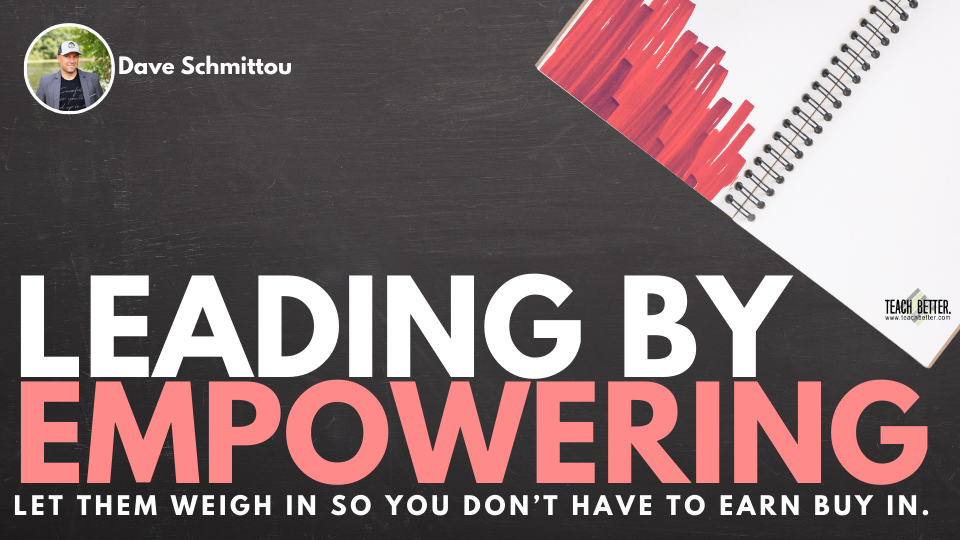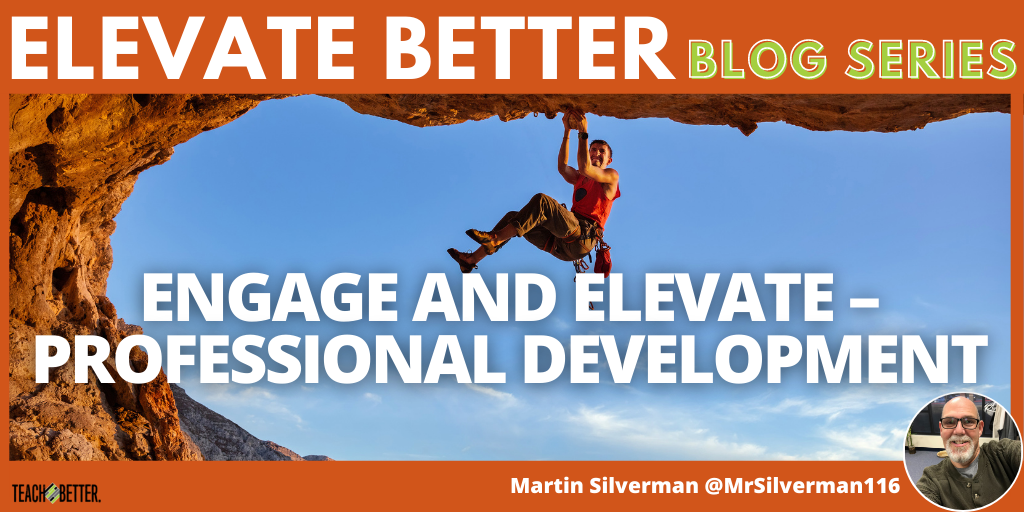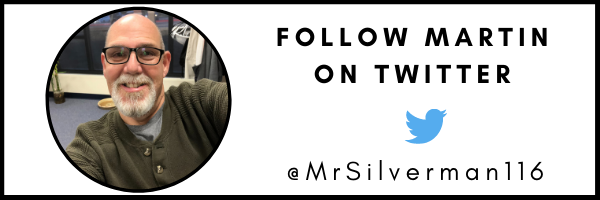TL;DR:
- This is the first post of a new blog series about how we engage and how we elevate that engagement. Beginning of the school year PD likely was one size fits all but did not fully reach all.
- Engage our audience by considering what we do as effective teachers who plan for diverse learners in the classroom. Learn what your audience needs, what they already know about the topic, and what questions they have to better meet their needs. Begin with an objective and end with a summative evaluation that informs you of what they learned or how to follow-up.
- To elevate PD, see beginning of the year PD as the beginning of a continuing conversation so you can plan follow-up activities intended to move the learning forward throughout the year.
About Engaging and Elevating
This summer while considering how to begin this school year, there was a theme that resonated when I considered our path through the school year ahead. The words that kept repeating were that we needed to re-engage our students and staff and go beyond expectations of all of us. I wrote a note in my notebook at the top of the page that said “re-engage and elevate.”
The purpose of this blog series is to consider ways that we engage at school throughout the year and provide examples of how we engage, and then how we elevate that engagement. This year is an opportunity to move our students, staff, and families beyond the deficit model that has been prevalent during the pandemic into a growth model. We owe it to our communities to provide our best work in order to create the conditions that will move us all forward.
Schools are a type of laboratory. We are allowed to try different methodologies in a protected space where we have some control over some of the variables. Certainly, we don’t get to have a true control group or control for the differences in students and staff, but we can use the space we have to both engage and elevate our school communities and attempt to provide the best possible outcomes for all.
Beginning of the Year PD
Here we are at the beginning of a new school year. Months of planning and many hours of labor have gone into providing an outstanding atmosphere for students, staff, and families. No doubt your school calendar has built-in professional development time either before school begins or early in the school year. Maybe you have already experienced the annual ritual of before-school PD.
Hopefully, you found it inspiring and useful. I suspect, however, that many felt we were not fully reached during these sessions. I believe that right around 100% of professional development is well-intended. The people that plan and produce PD are attempting to convey their ideas and show us strategies that could be useful as we begin this school year. Unfortunately, we often fall into the trap of “do as I say, not as I do” when it comes to professional development.
Thinking of the long-term learning from professional development helps us to not only engage learners but to elevate their practice! Click To TweetHow is typical professional development done?
The typical beginning of school PD takes place in a large group with a diverse set of learners. Some of us are well-seasoned, and some are just setting out on our journey as a teacher or administrator. The presenters stand in front of the group. They might do an ice-breaker activity or tell an inspiring story. Very often, they have visuals, usually a PowerPoint presentation or something like that. They tell us they’re not going to read the slides, but in most cases, they do just that.
The presentation is very meaningful to them as they have often spent many hours creating and recreating it. The information presented is to the novices or the big middle of the audience that are not familiar with the topic (curriculum initiative, vision development, SEL, etc.). Everyone leaves with some information. But there is no way for the presenter to know how and where they have reached the audience. So how can we adjust professional development to engage and then elevate our people?
We can ENGAGE our audience in professional development!
As a great place to start, I would suggest that those of us who present professional development to a group attempt to plan our learning time with activities that will allow us to engage our audience to a greater extent. This begins in the pre-development stage. What does our audience need to learn right now? What are we going to present? Who is the intended audience for our presentation? What do we intend for our audience to take away from the presentation? How will we know if we have been successful? If these questions sound familiar to you, they are exactly the ones effective teachers use to plan lessons for the diverse classrooms they are in front of each day.
Think about your current evaluation instrument.
There is almost assuredly a section where you are rated on your ability to plan for a diverse classroom, provide accommodations and modifications for learners with different needs, monitor student learning, adjust your presentation as needed, and evaluate outcomes to inform future instruction, etc. This is what we preach to teachers and leaders. Yet when we present to them, we often forget all of these elements.
The beginning of all of this planning would be to ensure that we know what our audience needs.
We can get an idea of this by looking at teacher data including academics, classroom management, style, interests, and expertise. A pre-development survey can offer data that is not readily available.
Ask about the topic you are going to present.
Find out what people already know about it, what they wonder about it, and how they feel about it. This information can help you plan a presentation that more closely meets the needs of your audience.
Begin your planning with a lesson objective.
End your presentation with a summative evaluation that doesn’t focus on how much they liked you. (We all have done those surveys after PD.) Instead, ascertain how much they actually learned from your presentation. Even better, this gives you an idea of how to follow up in the future.
[scroll down to keep reading]
Now, let’s ELEVATE professional development…
If we move away from thinking of the beginning of year professional development as an event, and more the beginning of a continuing conversation, we can plan follow-up micro-activities that are intended to move the learning forward during the rest of the school year. Using the example of a new curriculum initiative, we can elevate the learning by using our PD evaluations to create a small group of learners that are on board and proficient with the initiative. That group can discuss ways they can provide demonstration lessons and coach the hesitant or less comfortable.
In my district, all 3rd-5th grade teachers attended a session this year on Math Talks. In this strategy, students and teachers talk through how they solve problems to show students various methods used in math. One of my 5th grade teachers was a trainer for this session. When we got back to campus, she modeled a Math Talk with a first-year 4th grade teacher. The other 4th grade teachers observed.
As a follow-up, the new teacher will use the strategy and then demonstrate it to a peer or administrative observer. The intention is to have her elevate her learning from the session and incorporate it into her routines. While the original session engaged teachers, the follow-up on campus elevates the learning by meeting the needs of individuals.
Many ways to engage and elevate professional development!
There are so many ways to elevate professional development!
- Provide follow-up sessions highlighting pieces of the original learning
- Use proficient learners as mentors and coaches
- Discuss practices in meetings or PLC
Thinking of the long-term learning from professional development helps us to not only engage learners but to elevate their practice!
About Martin Silverman
Martin Silverman is a father, grandfather, husband, and long-time educator in beautiful San Antonio, Texas. He’s committed to providing the best educational experience for the students and families at Salinas Elementary school where he’s principal. Martin has worked in urban, suburban, and rural districts as a teacher and administrator. His interests are in creating and nurturing school culture, providing enriching experiences for students and families, and developing future teachers and administrators.
As a former bilingual teacher and administrator, Martin is committed to providing ELL students with quality programs to develop their unique skills. He hosts a podcast called The Second Question. It highlights educators and provides them a forum to discuss ideas, and to honor the teachers that have influenced their lives.




